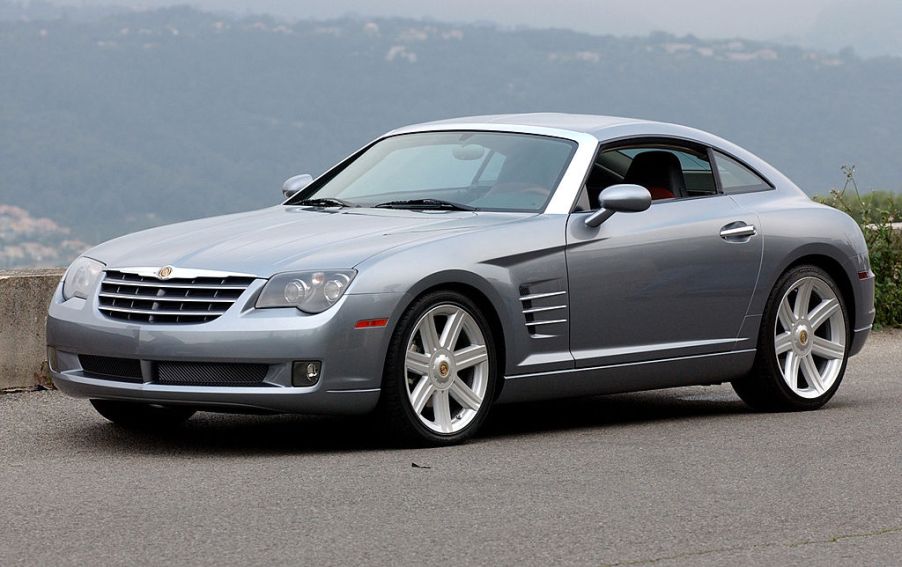
Was the Chrysler Crossfire Really That Bad?
If there was a car version of a Hall of Shame somewhere, you could easily imagine such flops as the Pontiac Aztek and the Yugo occupying some exhibit space.
These ill-fated vehicles were disastrous in terms of engineering, quality, and sales, so the contempt that car communities hold for them is definitely deserved. But would you lump the short-lived Chrysler Crossfire sports car in this same catastrophic category? Buckle up, dear reader, as we answer this question by navigating the rocky road that led to the Crossfire’s untimely demise.
Chrysler Crossfire: A real American sports car?

Dreamed up in collaboration with Daimler-Benz, the Crossfire concept car was intended to evoke a passionate emotional response from the public when it debuted at the 2001 North American International Auto Show. Furthermore, the Crossfire intended to share 39% of its components from Mercedes-Benz products.
The automotive media and general public largely approved of the Chrysler Crossfire concept car. Specifically, reviewers praised its bold sculpted lines, aggressive proportions, and interesting styling touches. So how was the Crossfire production model received when it hit dealership showrooms in 2003?
Love-it-or-hate-it styling
Concept cars tend to lose some of their visual mojo when they make it to production. Unfortunately, this was also the case with the Crossfire.
Styling cues like the rakish fastback profile, distinctive hood lines, and boat-tail rear made it onto the production Crossfire. However, the more menacing headlights, front grille, and retro split windshield didn’t make the cut.
Unlike the boat-tail featured on the concept car, the production model had an awkward crouch. Automotive journalist Jeremy Clarkson even went so far as to claim that the profile of the Crossfire looked like a dog doing its business. Woof.
Beauty is more than skin-deep

Sadly, the red and black leather on the concept car didn’t make it into production, and neither did the charmingly cartoonish features.
Again, it’s to be expected that not every fetching feature found on a concept car will make it to the production model due to safety and budget constraints. However, the interior of the production Crossfire lost virtually every neat styling cue. Just take a look at the shot of the uninspired cockpit above. Chrysler bathed the production model’s dashboard in a sea of cheap-looking and fake-feeling plastics.
To make matters worse, the high beltline and chopped roof turned the visibility of the Crossfire into a claustrophobic nightmare. At least the Crossfire came with a respectable amount of standard amenities like huge alloy wheels, keyless entry, and a decent Becker sound system.
Was the Crossfire any fun to drive?

If a sports car drives well, then it shouldn’t matter if the profile resembles a canine relieving itself. So did the Chrysler Crossfire redeem itself by offering an engaging driving experience?
Yes and no.
With the SLK320’s 3.2-liter V6 producing 215 hp and 229 lb-ft of torque powering the 3,100 lbs Crossfire, acceleration was adequate if not authoritative. Moreover, Chrysler offered either a six-speed manual or five-speed automatic transmission, both borrowed from the SLK320. Sensing a pattern yet? Both transmissions were compliant, if lackluster. However, the manual makes better use of the Crossfire’s powerband.
The Crossfire shared the same braking setup as the SLK320: 11.8-inch vented front rotors and 10.9-inch solid rear rotors. Additionally, braking performance was solid, if not forgettable. Overall, the Chrysler Crossfire delivered passable performance, but it didn’t really excel in any particular metric.
Competitors like the Nissan 350Z and Mazda RX-8 offered better performance and driving dynamics for about $5,000 to $7,000 less than the Crossfire’s $33,620 MSRP. On the other hand, some buyers felt that the inflated price was a fair trade-off, given that the Crossfire offered more distinctive styling and the cachet of sharing some Mercedes lineage.
Did the Roadster and SRT-6 models boost the Crossfire’s cred?

For the 2005 model year, Chrysler diversified the Crossfire lineup by offering a roadster variant as well as a high-performance SRT-6 model packing the supercharged 330 hp 3.2-liter V6 straight out of the Mercedes-Benz SLK32 AMG.
The Crossfire Roadster retained the distinctive styling features of the coupe model but addressed the fussy hunchbacked profile. Furthermore, the indisputable hidden jewel of the Crossfire lineup was the SRT-6. For instance, the SRT-6 packed enough punch to rocket from 0-60 mph in just five seconds flat. Moreover, the Crossfire SRT-6 also benefited from a sport-tuned suspension, bigger brakes, grippier tires, and racy cosmetic tweaks such as a larger fixed wing.
Chrysler also added a dash of panache to the SRT-6 interior with pseudo-suede trim on sport bucket seats and an ambitious 200 mph speedometer. Never mind that the SRT-6 was limited to 154 mph– the hilariously optimistic speedometer pleases the inner eight-year-old in us all.
Best of all, the 2005 Chrysler Crossfire SRT-6 had a sticker price of just $46,095 and $49,995 for the coupe and convertible, respectively. Compared to the $53,000 2005 Porsche Boxster S, the SRT-6 models delivered far more bang for the buck.
Here’s how the Chrysler Crossfire should be remembered
U.S. sales of the Crossfire started strong, with almost 15,000 units sold in 2004 and 2005. However, sales plummeted to roughly 2,000 cars in 2008. What’s important to take into consideration is that the Crossfire models fulfilled Chrysler’s objective of attracting a lot of attention to the brand.
Moreover, the ill-remembered sports car minimized production costs through parts-sharing with then-partner Mercedes-Benz. Above all, we should remember the Crossfire as the flawed-yet-funky step to pave the way for future Chrysler SRT models.
Despite the ramblings of ill-informed car enthusiasts, the Crossfire wasn’t all that bad.
Editor’s note: Jimmy Brown contributed to this article.



